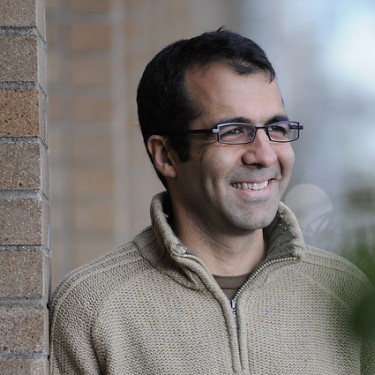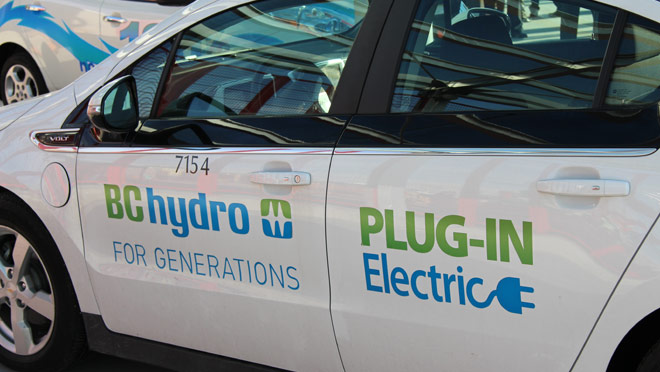What does it mean that British Columbia has decreed that every new vehicle sold will be zero-emission within 21 years? Experts contacted by The Tyee believe it’s a transformative decision that sets a clear timeline for the phase-out of gas-powered cars in the province and pushes back against apathy for alternatives.
“The oil industry loves to say ‘sure, electric cars, but it’s not going to happen tomorrow, we’re not going to stop using oil tomorrow, so let’s build another pipeline,’” said Mark Jaccard, a professor of sustainable energy at Simon Fraser University and an expert on climate policy.
“When a government says, ‘by 2040 no cars except zero emissions will be sold,’ that really signals to everybody that this is a fundamental shift.”
As Jaccard and pretty much everyone else in his field will say, if we want any chance of keeping global temperature rise below doomsday levels, we have to stop making, selling and driving gas and diesel-powered vehicles. The market for electric vehicles, while still quite small, is growing rapidly.
But research suggests that the people buying these vehicles tend to be relatively affluent and live in single-family homes with garages where they can charge their vehicle’s battery at night. Prices are quickly coming down, but for many Canadians electrics are not yet affordable enough to be a primary vehicle.
Yet that may soon change — at least in B.C. When the NDP government released in December its wide-ranging climate plan, there was lots of coverage. Yet one of its most revolutionary policies got considerably less attention. That would be the NDP’s promise that every new vehicle sold in the province in 2040 will be zero-emission, which could mean electric, hydrogen or other carbon-neutral alternatives. Gas-powered cars will still be on our roads for decades. But the era where they completely dominated transportation could be coming to an end.
Electrics make up less than five per cent of new vehicle sales in B.C. Pushing that number close to 100 per cent in two decades would mean a serious market transformation. It will require a mass build-out of charging stations and incentives that make zero-emissions vehicles more affordable to the majority of people.
Targets start just seven years away
Ask most people to name a climate policy in B.C. and they are likely to pick the carbon tax. Since it was introduced in 2008, the economy-wide price on carbon emissions has been lauded around the world. A 2016 op-ed in the New York Times claimed the carbon tax “sets British Columbia apart as a leader on the cutting edge.”
Though B.C.’s emissions have gone down five to 15 per cent since the tax was introduced, the current price of $35 per tonne is nowhere near high enough to force the market shifts needed to hit the relatively safe warming threshold of 1.5 degrees Celsius. For that, a recent United Nations report estimated, governments need to impose a politically impossible carbon price of between $135 to $5,500 per ton.

With only a dozen years or so left to avoid catastrophic damage from climate change, it’s clear we need a wide range of policies that specifically target polluting sectors of the economy. The electric car policy B.C. announced in its climate plan is known as a Zero Emission Vehicle mandate, or “ZEV” for short. The gist of the policy is that it sets clear sales goals for vehicles that don’t contribute to climate change. Within seven years, 10 per cent of the sales done by B.C. new car dealers must be zero-emission vehicles. In 2030, it rises to 30 per cent, then 100 per cent in 2040.
The province of Quebec and 10 U.S. states have some version of the policy. Like many climate innovations, it was first adopted in California. By setting clear targets for non-fossil-fuel-burning cars, it gives carmakers the motivation and confidence to invest in new technology. “It was one factor that really helped Tesla start,” Gil Tal, research director at the Plug-in Hybrid & Electric Vehicle Research Center with the University of California, Davis, told The Tyee. “What the ZEV mandate is doing is forcing the car companies to do more long-term thinking.”
Without the policy it’s likely the auto giants would keep making regular cars, even as technology for electric vehicles improves. In the short-term, selling SUVs and other gas models is a surer way to profit. “There’s a good chance they would delay and not do anything,” Tal said.
Even sales targets that look relatively modest can shift the market in interesting ways. In order to meet B.C.’s 2025 target, new car dealers have to more than double the amount of zero emission vehicles they’re now selling. They’ve got “to bring the price of the electric cars down to what middle-class people will buy,” Jaccard said.
One way car dealers might achieve this, Jaccard said, is by raising the price of higher-end Porches and other vehicles by, say, $500 or $1000, and then using that money to make price reductions for electric models.
They’re “not going to get really low-income people to buy these right away,” Jaccard said. But in the short-term, at least, the B.C. mandate is “getting sellers of vehicles to cross-subsidize from the wealthy to the middle class,” he explained.
How car dealers are taking it
Car dealers in B.C. aren’t entirely thrilled about the policy. But they acknowledge that meeting its goals isn’t out of the question. “Current trends would suggest the immediate target is likely achievable,” Blair Qualey, President and CEO of the New Car Dealers Association of BC, wrote to The Tyee in an email. He’s less confident about the full gasoline model phase-out.
“Even with incentives, [electric vehicles] are still unaffordable for many British Columbians,” Qualey argued. For mass adoption to be feasible, he went on, there needs to be infrastructure to support it: “We lack a comprehensive charging network, particularly in the Interior and the North.”
People who own electric vehicles tend to do the majority of their charging — about 80 per cent — at their home. “You plug in at night and then you go to the car in the morning and you basically have a full tank of gas,” Suzanne Goldberg, director of policy Canada for ChargePoint, a California-based company that operates a global network of charging stations.
Electric vehicle owners in B.C. also charge at work, assuming there are chargers available, or at one of over 1,000 public charging stations across the province, where it could take an hour or two to fully replenish your battery. The B.C. NDP plans to grow the current network of fast-charging stations, where charging may take only a half-hour or so, from 71 to 151 sites.
Clearly these numbers have to grow immensely. “At this point there is not a lot of charging infrastructure,” Sumeet Gulati, a professor in Environmental and Resource Economics at the University of British Columbia, told The Tyee. He thinks this holds back low and middle-income earners from buying electric vehicles. Right now, with most charging having to take place at home, electric vehicles make more sense as a second or third family vehicle for local trips.

“It’s really hard for someone who’s not relatively rich to have this as a second car,” Gulati said. But a mass build-out of public charging infrastructure that would let people charge their cars easily and affordably all over their communities could be a “big equalizer,” Gulati continued. It could allow people across the income spectrum to own an electric car as their main vehicle.
Link rebates to incomes?
To accelerate that process, though, the price of buying an electric vehicle still needs to come down. Since 2011, the provincial government has offered rebates of up to $6,000 for people buying new clean energy vehicles.
The NDP promised in its recent climate plan to increase the program by $20 million this year. Gulati supports the policy, but with an important caveat. He thinks that rebates should be linked to people’s incomes, and not merely reward people who would have bought an electric car anyway.
“I don’t like the idea of general rebates,” Gulati explained. “The rich can afford that price so there’s no reason we should be subsidizing them. We should be subsidizing the poor.”
Even still, the economics of electric vehicles are rapidly improving. Bloomberg New Energy Finance, a leading tracker of the low-carbon shift, forecasts that the upfront costs of electrics will become competitive with fossil fuel models by 2024, and that by 2040 over half of all new car sales worldwide will be electric, largely due to rapid growth in China.
That said, even if B.C. can meet its target of only selling new zero emission vehicles by 2040, it could take decades for people to retire gas cars that they already own, or that they buy from used-car dealerships. “We’re still going to see many regular cars on the road for many years,” Tal said. “It’s a slow process.”
That means we’ll still need oil to fuel those cars. But if forecasters like Bloomberg are correct, demand for gasoline and diesel will steadily decrease. Electric vehicles globally could displace 7.3 million barrels of transportation fuel per day by 2040. That’s three times the amount Canada consumes daily now.
Which means that building new oil pipelines and expanding high-cost industries such as the oil sands doesn’t make a whole lot of financial sense.
For Karen Tam Wu, managing director of British Columbia at the Pembina Institute, the NDP climate plan is an acknowledgment of this reality.
“[It’s] basically a sign that we are moving away from fossil fuels to clean energy,” Wu told The Tyee. “We know we can be successful in a clean economy, so we’re seizing the moment and saying ‘we’re going forward.’” ![]()
















Tyee Commenting Guidelines
Comments that violate guidelines risk being deleted, and violations may result in a temporary or permanent user ban. Maintain the spirit of good conversation to stay in the discussion.
*Please note The Tyee is not a forum for spreading misinformation about COVID-19, denying its existence or minimizing its risk to public health.
Do:
Do not: